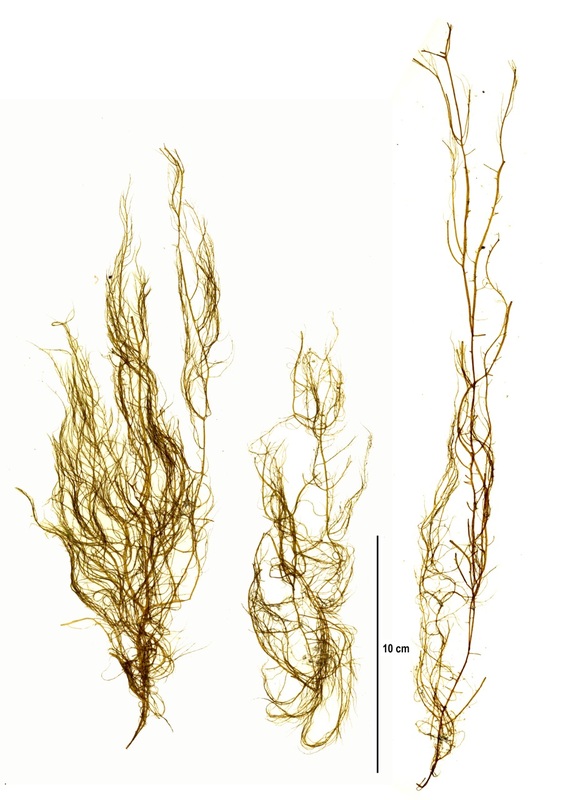Golden sea hair • Dictyosiphon foeniculaceus
|
Specimen collection number SCL 15380 in the UBC Herbarium Algae Database. Search the collection number in the database for more information on this specimen, or search the species for further occurrences. Images courtesy of Sandra Lindstrom.
|
Identification
This brown seaweed has a highly branched golden brown thallus that grows to 40 cm tall. Branches are delicate, and the branching pattern can be opposite, alternate, or irregular. There are multiple orders of branches, which decrease in size away from the main axis. This species tends to look like a tangled mess of branches. Habitat & Range Golden sea hair grows on rock, epiphytically on other seaweeds, and in free-floating mats. It grows along protected shorelines and in estuaries. In the Pacific Northwest its range extends from the Aleutian Islands to northern Washington; it also ranges through the Bering Sea north to the Arctic Ocean well as west to Russia and Japan. It is also found in the North Atlantic. Similar Species Witch's hair (Desmarestia aculeata) is similarly stringy and highly branched. It tends to be darker in colour, grows to 2 m tall, and has an alternating branch pattern. Stringy acid kelp (Desmarestia viridis) is also stringy and light to medium brown. It has an opposite branch pattern, and it turns greenish when damaged or dry. Both only grow on rock, and can be found in more exposed locations than golden sea hair. Neither is found in estuarine habitats. |
References
Lindberg, M. and Lindstrom, S. (2010). Dictyosiphon foeniculaceus Golden Sea Hair. Seaweeds of Alaska. Accessed 11/04/2016.
O'Clair, R. and Lindstrom, S. Dictyosiphon foeniculaceus (Hudson) Greville. In Klinkenberg, Brian. (Ed.). E-Flora BC: Electronic Atlas of the Plants of British Columbia. Lab for Advanced Spatial Analysis, Department of Geography, University of British Columbia, Vancouver. Accessed 11/04/2015.
Authors and editors of page
Kelly Fretwell (2016).
Lindberg, M. and Lindstrom, S. (2010). Dictyosiphon foeniculaceus Golden Sea Hair. Seaweeds of Alaska. Accessed 11/04/2016.
O'Clair, R. and Lindstrom, S. Dictyosiphon foeniculaceus (Hudson) Greville. In Klinkenberg, Brian. (Ed.). E-Flora BC: Electronic Atlas of the Plants of British Columbia. Lab for Advanced Spatial Analysis, Department of Geography, University of British Columbia, Vancouver. Accessed 11/04/2015.
Authors and editors of page
Kelly Fretwell (2016).




